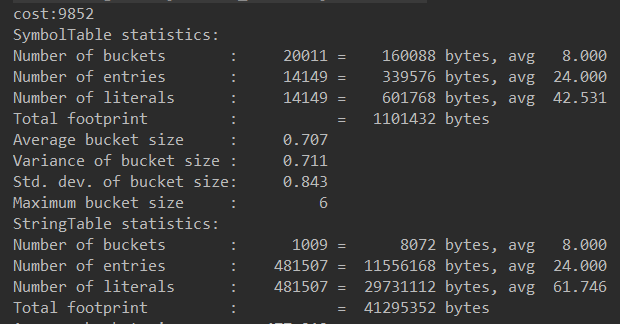JDK1.8中StringTable的底层类似于HashTable,由数组和链表实现,数组又称为桶数组。比如有这样一段代码:
public class Demo4 {
public static void main(String[] args) {
int i = 0;
System.out.println(i);
}
}我们设置虚拟机参数“-Xmx10m -XX:+PrintStringTableStatistics -XX:+PrintGCDetails -verbose:gc“,参数具体的意思是 设置堆内存大小为10M,输出StringTableStatistics信息,输出GC细节。运行代码控制台会有相应的输出,主要看下StringTable部分。默认桶的个数是60013,存储的字符串对象个数为1752,串池中字符串常量个数为也是1752,总的占用空间约为0.6M。上面代码只是输出i,但串池中常量个数为1752,那是因为类名、方法名等这些数据也是以常量的形式存在串池中。

接着稍微改动代码:
public class Demo4 {
public static void main(String[] args) {
int i = 0;
// 往串池中添加100个字符串
for (int j = 0; j < 100; j++) {
String.valueOf(j).intern();
i++;
}
System.out.println(i);
}
}这时候我们可以看到串池中字符串个数为1871,比默认多了100个。

继续用上述代码做实验,这会for循环次数为10000,看控制台输出有什么变化。

字符串个数为7451并不是11751,因为我们设置了堆内存大小为10M,存10000个字符串对象的话堆内存发生了MinorGC,将一些无用的对象回收了。

调优:
- 调优主要是对StringTable大小的设置,如果程序中字符串数量非常多,那么可以将桶个数设置大一些,具体参数为 -XX:StringTableSize = 大小,默认是60013,最小是1009。有这样一段代码:
public class Demo5 {
public static void main(String[] args) throws IOException {
try (BufferedReader reader = new BufferedReader(new InputStreamReader(new FileInputStream("linux.words"), "utf-8"))) {
String line = null;
long start = System.nanoTime();
while (true) {
line = reader.readLine();
if (line == null) {
break;
}
line.intern();
}
System.out.println("cost:" + (System.nanoTime() - start) / 1000000);
}
}
}"linux.words"中有480000个字符串,读取文件然后将字符串放入串池,记录整个过程消耗时间,以ms为单位并且打印信息。默认桶个数下消耗时间为0.57秒。

我们设置 -XX:StringTableSize=1009再观察下消耗时间,变为了9.852秒。所以可根据业务场景来设置桶个数大小。

- 如果应用里有大量字符串并且存在很多重复的字符串,可以考虑使用intern()方法将字符串入池,而不是都存在Eden区中,这样字符串仅会占用较少的空间。
来源:oschina
链接:https://my.oschina.net/u/4266023/blog/4387360